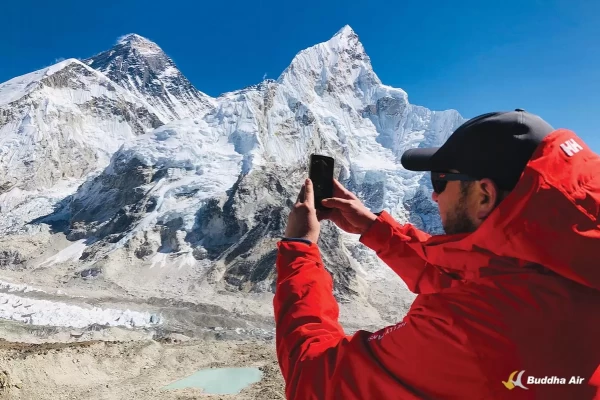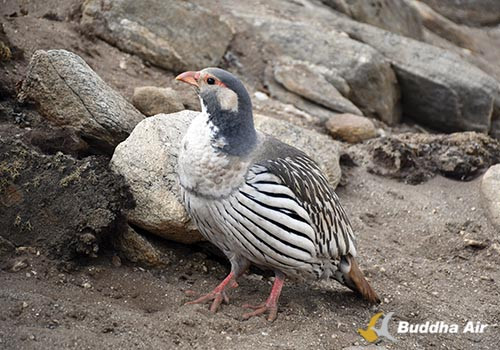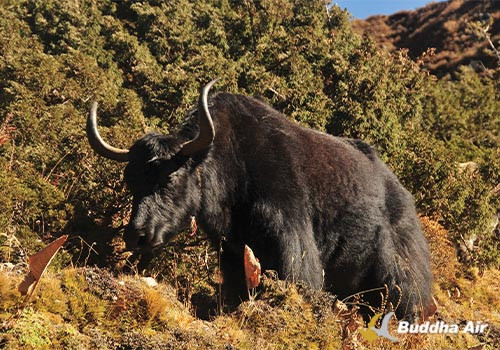Kala Patthar: Sublime View of Mount Everest | Buddha Air

Mount Everest is the highest peak in the world. Trekkers dream of reaching the base camp at least once in a lifetime. They want to embrace Everest right in front of their eyes, experience adventure, and get rid of stress.
Every year, thousands of trekkers travel to the Everest region to fulfill this dream. Mountain climbers stay at Everest base camp for acclimatization. They continuously practice climbing, going up and down, before setting to summit Everest.
Trek to Mount Everest Base Camp and Mt Everest
Those who want to experience the joy of trekking spend some time at the base camp. They rejuvenate themselves, take pictures and videos, and return in a blessed mood.
Everest trekking is also done to study Himalayan civilization and Sherpa culture. This requires physical fitness, willpower, time, and money.
The foot trail passes through Everest National Park, which UNESCO listed as a World Heritage Site in 1979.
Trekkers can enjoy snow at Everest base camp and see different mountains, including Lhotse, Nuptse, Pumori, and Everest. Sipping warm water amidst the cold wind and gazing at the panoramic view gives a feeling of fulfillment.

A fair is held at the base camp during the mountain climbing season in April and May. It is for climbers and the assisting members of the expedition team. Hundreds of colorful tents make the area spectacular. The tents erected on top of the Khumbu glacier give a strange feeling and provide an exotic experience.
Everest can be trekked throughout the year, but the best seasons are mid September to December and March to May. The journey is exciting even in the monsoon season when the empire of mist and mountain flora is in full swing. Few tourists travel during the snowy season and monsoon.
Only the peak of Everest is visible from the base camp. Kala Patthar is the viewpoint from which one can enjoy the beautiful view of Everest during the trek. It also offers an exotic view of sunrise and sunset.
Kala Patthar
Kala Patthar (5,550 meters) is the crown of Gorakshep. After climbing steeply for 3 hours from Gorakshep (5,180 meters), one reaches the top of Kala Patthar. As you climb uphill, you are greeted by mountain birds along the foot trails. It is a real adventure to climb the mountain and feast in the spectacular views, though the trek is arduous.


Gorakshep is Kala Patthar's base camp. Trekkers can find some hotels in Gorakshep, but there are no hotels, lodges, or restaurants in Kala Patthar or Everest Base Camp.
It takes three hours to reach Everest Base Camp from Gorakshep. One can observe mountains and avalanches while trekking.
It is called 'Kala Patthar' because it is a mountain of black-colored rocks.
The name Nuptse, which translates to ‘west peak’ in Sherpa language, perfectly captures Nuptse's position just west of Everest. Lho Tse, in Sherpa, means the ‘south peak.’ Kangtega Mountain is seen near Tengboche. 'Kangtega' means a saddled horse. The mountain looks like a saddled horse, hence the name.
Similarly, Pumori means ‘mountain daughter.’ In Sherpa, 'Pumo’ means young girl or daughter, and ‘Ri’ means mountain. Climbers sometimes refer to Pumori as ‘Everest's Daughter.’
Gorakshep gets its name from a bird, the raven, which the Sherpas call 'Gorak.' ‘Shep’ means dead. According to a legend, someone who saw a dead raven in this mountain named it ‘Gorakshep.’
Gorakshep and Lobuche were formerly pasturelands where cattle were reared. Trekking tourism started in this area after Sir Edmund Hillary and Tenzing Norge Sherpa climbed Mount Everest(8,848.86 meters) on May 29, 1953.
Everest trek provides an exciting experience. The trip to the unique Himalayan topography is awe-striking.
Mules, horses, and yaks are used as means of transportation in this area. Mules are prohibited beyond Namche village. Yaks and horses carry the goods in the upper region.
One can view Everest from Namche. It is fun to climb uphill and see mountains like Kongde, Thamserku, Ama Dablam, Pumori, and others. Manes (prayer wheels), monasteries, and stupas associated with Buddhist pilgrimage are found in this region.
Also read: Sacred Mountains of Nepal: Pilgrimage Sites and Its Significance
Khumjung Monastery, Thame Monastery, Rimijung Monastery, Pangboche Monastery, Tengboche Monastery, and Dibuche Monastery are famous in the Everest region. The oldest Pangboche monastery in the Khumbu region is believed to be around 500 years old.
All along the foot trails, there are hotels and restaurants that provide food and lodging facilities. They serve everything from regular Nepali daal bhaat to pizza.
Bazars in Lukla and Namche have everything a hiker needs. Both places have banks with ATM facilities. Internet access is available, but it is expensive. A small hydropower plant is the source of Namche’s electrification. Solar power is used beyond Namche.

Usually, the Everest trek is completed in twelve days. If one wants to do all three passes, it will take twenty-one days. It requires sixteen days to reach Everest Base Camp via Gokyo.
Many of us dream of trekking Everest. Trekking helps us embrace the ups and downs of life. Patience, courage, willpower, perseverance, and honesty lead to success. Therefore, it is recommended that one embark on a trek with careful consideration and be assisted by a trekking guide. Bon voyage!
How to Reach Kala Patthar
Lukla, the entrance to Everest, can be accessed by two way. There are flights from Kathmandu and Manthali to Lukla, each lasting 40 minutes from Kathmandu and 20 minutes from Manthali. The trek starts from Lukla.
The distance by road is 277 km from Kathmandu to Salleribazar, the headquarters of Solukhumbu, via Khurkot, Ghurmi, and Okhaldhunga. Local jeeps are available from Salleri to Paiyan, which is about 50 km offroad. The trek starts from there. There is a plan to extend the road only to Chaunrikharka, the center of Pasang Lhamu Rural Municipality
